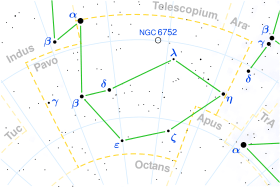Xi Pavonis
ξ Pavonis, Latinized as Xi Pavonis, is a triple star[8] system in the southern constellation of Pavo. It is visible to the naked eye as a faint star with a combined apparent visual magnitude of 4.35[2] The system is located approximately 440 light years from the Sun based on parallax,[1] and it is drifting further away with a radial velocity of +12 km/s.[5]
| Observation data Epoch J2000 Equinox J2000 | |
|---|---|
| Constellation | Pavo |
| Right ascension | 18h 23m 13.64610s[1] |
| Declination | −61° 29′ 37.9364″[1] |
| Apparent magnitude (V) | 4.35[2] |
| Characteristics | |
| Spectral type | K4III[3] |
| U−B color index | +1.55[4] |
| B−V color index | +1.46[2] |
| Astrometry | |
| Radial velocity (Rv) | +12.2±0.9[5] km/s |
| Proper motion (μ) | RA: −5.985[1] mas/yr Dec.: −0.538[1] mas/yr |
| Parallax (π) | 7.3600 ± 0.3753[1] mas |
| Distance | 440 ± 20 ly (136 ± 7 pc) |
| Absolute magnitude (MV) | −1.16[2] |
| Orbit[6] | |
| Period (P) | 2,214 d |
| Eccentricity (e) | 0.26 |
| Periastron epoch (T) | 2418076.2 JD |
| Argument of periastron (ω) (secondary) | 187.2° |
| Semi-amplitude (K1) (primary) | 17.9 km/s |
| Details | |
| Radius | 54.82+0.32 −3.92[1] R☉ |
| Luminosity | 729±42[1] L☉ |
| Temperature | 4,051+153 −117[1] K |
| Other designations | |
| Database references | |
| SIMBAD | data |
This system forms the double star GLE 2, whose companion's magnitude is 8.6 with a 3.3″ angular separation, which was discovered by Australian amateur astronomer Walter Gale[9] in 1894. The primary component is itself a single-lined spectroscopic binary[10][11] with an orbital period of 6.06 years and an eccentricity of 0.26.[6] The visible member of this inner pair is an aging giant star with a stellar classification of K4III.[2]
References
- Brown, A. G. A.; et al. (Gaia collaboration) (August 2018). "Gaia Data Release 2: Summary of the contents and survey properties". Astronomy & Astrophysics. 616. A1. arXiv:1804.09365. Bibcode:2018A&A...616A...1G. doi:10.1051/0004-6361/201833051. Gaia DR2 record for this source at VizieR.
- Anderson, E.; Francis, Ch. (2012). "XHIP: An extended hipparcos compilation". Astronomy Letters. 38 (5): 331. arXiv:1108.4971. Bibcode:2012AstL...38..331A. doi:10.1134/S1063773712050015. Vizier catalog entry
- Houk, Nancy (1978). "Michigan catalogue of two-dimensional spectral types for the HD stars". 1. Ann Arbor: Dept. of Astronomy, University of Michigan. Bibcode:1975mcts.book.....H. Cite journal requires
|journal=(help) - Mermilliod, J. C. (2006). "Homogeneous Means in the UBV System (Mermilliod 1991)". VizieR On-line Data Catalog: II/168. Originally Published in: Institut d'Astronomie. 2168. Bibcode:2006yCat.2168....0M.Vizier catalog entry
- Wilson, R. E. (1953). General Catalogue of Stellar Radial Velocities. Carnegie Institution of Washington. Bibcode:1953GCRV..C......0W. LCCN 54001336.
- Pourbaix, D.; et al. (2004). "SB9: The Ninth Catalogue of Spectroscopic Binary Orbits". Astronomy & Astrophysics. 424: 727–732. Bibcode:2004A&A...424..727P. doi:10.1051/0004-6361:20041213.
- "ksi Pav". SIMBAD. Centre de données astronomiques de Strasbourg. Retrieved 2019-10-08.
- Eggleton, P. P.; Tokovinin, A. A. (September 2008). "A catalogue of multiplicity among bright stellar systems". Monthly Notices of the Royal Astronomical Society. 389 (2): 869–879. arXiv:0806.2878. Bibcode:2008MNRAS.389..869E. doi:10.1111/j.1365-2966.2008.13596.x.
- Argyle, Bob (August 2008). "Double Star of the Month". The Webb Deep-Sky Society. Retrieved 2019-10-08.
- Dommanget, J.; Nys, O. (2002). "CCDM (Catalog of Components of Double & Multiple stars) (Dommanget+ 2002)". VizieR On-line Data Catalog: I/274. Originally Published in: Observations et Travaux 54. 1274. Bibcode:2002yCat.1274....0D. Vizier catalog entry
- Malkov, O. Yu.; Tamazian, V. S.; Docobo, J. A.; Chulkov, D. A. (2012). "Dynamical masses of a selected sample of orbital binaries". Astronomy & Astrophysics. 546: A69. Bibcode:2012A&A...546A..69M. doi:10.1051/0004-6361/201219774. Vizier catalog entry
